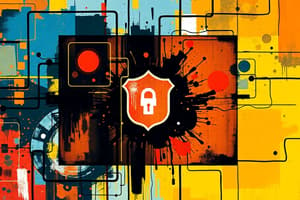Podcast
Questions and Answers
An industrial security plan is developed following a risk assessment. What is the primary purpose of this plan?
An industrial security plan is developed following a risk assessment. What is the primary purpose of this plan?
- To serve as a marketing tool for potential clients.
- To detail the historical security incidents of the facility.
- To outline preventive measures and response protocols. (correct)
- To comply with local regulations only.
How do modern surveillance systems enhance industrial security beyond traditional cameras?
How do modern surveillance systems enhance industrial security beyond traditional cameras?
- By reducing the need for personnel training.
- By offering only improved video resolution.
- By eliminating the need for physical security measures.
- By incorporating AI for facial recognition and anomaly detection. (correct)
What is the main goal of personnel training and awareness programs in industrial security management?
What is the main goal of personnel training and awareness programs in industrial security management?
- To limit employee access to sensitive information to reduce insider threats.
- To ensure employees are educated about security protocols and emergency procedures. (correct)
- To reduce the number of security personnel needed.
- To eliminate the need for regular security drills.
In the event of a security breach, what is the primary role of well-defined response protocols?
In the event of a security breach, what is the primary role of well-defined response protocols?
Why is continuous monitoring and adaptation integral to industrial security management?
Why is continuous monitoring and adaptation integral to industrial security management?
Why is compliance with regulations a core area of industrial security management?
Why is compliance with regulations a core area of industrial security management?
What is the role of industrial security management in manufacturing plants?
What is the role of industrial security management in manufacturing plants?
How does blockchain technology enhance industrial security?
How does blockchain technology enhance industrial security?
What role does employee training and awareness programs play in the future of industrial security management?
What role does employee training and awareness programs play in the future of industrial security management?
Why is it important to balance robust security measures with productivity and morale in industrial security management?
Why is it important to balance robust security measures with productivity and morale in industrial security management?
Flashcards
Integrated Planning
Integrated Planning
Beginning with in-depth risk assessments and formulating a tailored plan with preventive measures and response protocols.
Advanced Technological Integration
Advanced Technological Integration
Integrating technologies like surveillance, AI, biometric verification, and intrusion detection for comprehensive security.
Personnel Training and Awareness
Personnel Training and Awareness
Educating employees about security protocols, emergency procedures, and confidentiality, reinforced by drills and simulations.
Response Protocols
Response Protocols
Signup and view all the flashcards
Continuous Monitoring and Adaptation
Continuous Monitoring and Adaptation
Signup and view all the flashcards
Compliance with Regulations
Compliance with Regulations
Signup and view all the flashcards
Security in Manufacturing Plants
Security in Manufacturing Plants
Signup and view all the flashcards
Security for Energy Facilities
Security for Energy Facilities
Signup and view all the flashcards
Security for Logistics and Transportation
Security for Logistics and Transportation
Signup and view all the flashcards
Security for Critical Infrastructure Sites
Security for Critical Infrastructure Sites
Signup and view all the flashcards
Study Notes
Core Areas of Industrial Security Management
- Industrial security management initiates with detailed risk assessments by security experts
- These experts analyze the vulnerabilities of the industrial facility, considering factors like location, industry, and past incidents
- The analysis leads to a tailored security plan with preventive measures and response protocols, which serves as the security framework's foundation
- Modern security integrates cutting-edge tech like AI for facial recognition and anomaly detection in surveillance
- Access control uses biometric verification for zone entry, while intrusion detection systems use sensors and alarms for real-time monitoring
- Employee training on security protocols, emergency procedures, and confidentiality is vital
- Regular drills help prepare for breaches or emergencies, ensuring quick response
- Industrial security management establishes step-by-step protocols for handling incidents from theft to natural disasters
- These protocols aim to ensure organized responses, reduce damage, and protect personnel
Continuous Improvement and Compliance
- Industrial security is dynamic, adapting to new threats and technologies through continuous monitoring
- Regular audits, assessments, and tech updates help stay ahead
- The system adapts and incorporates new security measures quickly
- Aligning with local and international regulations is a must
- A robust security system helps facilities comply, avoiding legal issues and building stakeholder trust
Applications of Industrial Security Management
- Industrial security is versatile, used across many sectors to ensure smooth operations and protect valuable assets
- Manufacturing plants use it to protect workers and machinery with access control, surveillance, and responsive protocols
- Energy facilities need robust security to prevent unauthorized access and sabotage, using surveillance, access control, and training
- Logistics and transportation rely on it to secure the supply chain with surveillance and access control, preventing theft and enhancing traceability
- Critical infrastructure safeguards water treatment plants and data centers, blending cybersecurity with physical measures
- Healthcare and pharmaceutical sectors use it to protect research, development, and patient care/well-being with advanced security measures
The Importance and Benefits
- Industrial security is vital due to physical, cyber, theft, vandalism, and terrorism threats
- Industries must protect valuable assets, sensitive data, and critical infrastructure
- Complying with regulations is essential, as is protecting proprietary information
- Security management mitigates risks and minimizes losses from theft or damage using surveillance and access control
- Protecting proprietary information through advanced protocols and secure data storage helps maintain a competitive edge
- Streamlined security protocols increase operational efficiency by minimizing disruptions from security breaches
- Real-time monitoring and response mechanisms help quickly resolve security issues
- Effective security builds trust with clients and stakeholders, fostering long-term relationships and new opportunities
Challenges and the Future
- Adapting to evolving threats requires security personnel to stay updated on emerging technologies and hacking methods through regular training
- Balancing security measures with a welcoming workspace avoids hindering productivity and morale
- Thoughtful implementation is key
- Integrating technologies like AI and biometrics can be complex and requires investment and training
- Budget constraints can limit access to advanced technologies; prioritize needs and use cost-effective solutions
- Insider threats from employees or third parties require robust controls, training, and monitoring with security awareness programs
- The future involves AI and Machine Learning for predictive threat analysis and real-time responses by identifying patterns and anomalies
- IoT integration will enable seamless monitoring through interconnected sensors and real-time data, enhancing situational awareness
- Blockchain will safeguard data integrity and transactions with its decentralized, tamper-proof nature, securing supply chains and access logs
- Training programs are vital for empowering employees to recognize and prevent threats by fostering a security-conscious culture
Trends
- Industrial security management is moving towards integrated systems that combine access control, video surveillance, and incident management into a unified platform
- This allows for centralized monitoring and control, streamlined incident response, and improved situational awareness.
- Securing IoT devices and the data they generate in industrial settings is a significant focus
- Implementing encryption, authentication, and regular software updates are crucial
- AI and ML are increasingly leveraged
- Allows predictive analytics, anomaly detection, and automated threat response
- Cloud-based solutions are gaining traction
- Offers centralised data storage, remote monitoring, and quick updates
- Physical security measures are evolving
- Advanced technologies improve effectiveness, especially in access control and surveillance
- Human Security requires training as a critical element
- Compliance with regulations is essential to avoid legal risks and protect data
Studying That Suits You
Use AI to generate personalized quizzes and flashcards to suit your learning preferences.




